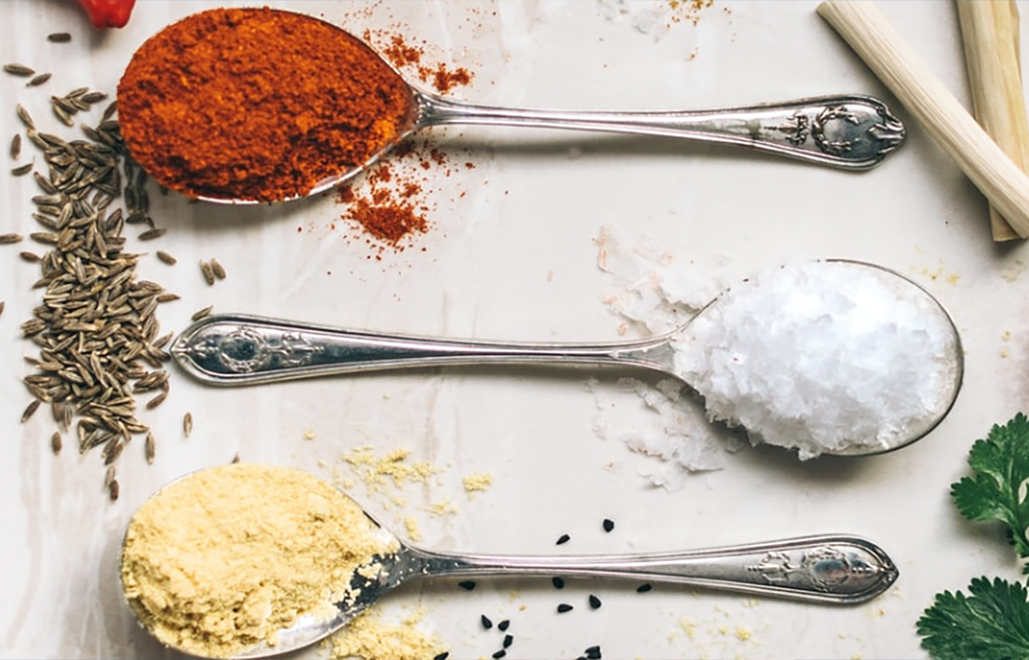Rasas
According to Ayurveda, food plays a vital role on our health and well-being. A food is determined by its own identity card. Among these different criteria we find, the tastes (flavors) or rasas.In order to determine the effect of food, Ayurveda establishes correlations between the taste of food and their role in the body.There are 6 rasas / 6 tastes: sweet, sour, salty, pungent, bitter and astringent.This is the first taste of a food, the primary flavor. Then comes secondary flavors: anurasas. For example:
- Garlic (pungent rasa, acidic/sweet, salty/bitter anurasa)
- Yellow lemon (acidic rasa, astringent anurasa) Raw spinach (sweet rasa, bitter anurasa)
- Green apple (acidic/sweet rasa, astringent anurasa)
Sweet rasa - Sweet (consisting of Earth and Water)
Energy: Cold - heavy, moist and unctuous.- The most common flavor found in most foods
- Beware that highly concentrated sugar can have a pungent rasa
- Natural sugars: honey, cane sugar, agave syrup, maple syrup...
- Fruits: pear, peach, banana, avocado, date...
- Grain: bread, pasta, rice, thorse, oats...
- Dairy products: milk, cheese, yogurt...
- Nuts: almond, cashew, coconut...
- Meat: poultry, lamb, beef, pork, fish, seafood
It increases Kapha, decreases Vata and Pitta
Beneficial benefits:- nourishes tissues and promotes growth
- alleviates prickly burn
- gives strength and vitality to the body
- increases mucus production
- wants to urinate often
- increases weight gain
- leads to heaviness and sluggishness
- excessive sleep
- disturbs digestion
- leads to constipation
- provokes eye disorders
- diminishes Agni (digestive fire)
- disbalances intestinal flora
Acid rasa - (made up of Earth and Fire)
Energy : Hot - Light and smoothAcidity is found in:- Fruits : tomatotamarind, citrus, mango, passion fruit, kiwi, grapes, yellow lemonlime...
- Dairy products
- Vegetables: radish, rhubarb, oseilla
- Permentations: miso, yogurt, aged cheeses, wine, vinegar, kombucha, sauerkraut and lacto-fermentations
It increases Pitta and Kapha, decreases Vata
Effects:- stimulates appetite
- increases saliva production
- diuretic effect, retains body fluids (urine, sweat...)
Beneficial benefits: Soothes Vata
- Aids digestion and absorption of nutrients
- Contributes to the breakdown of fats
- Makes the body salivate, moisturizes and softens tissues
- Acts excretory functions
- gives intense thirsty feeling
- provokes alternating constipation and diarrhea
- dental problems
- hair loss
- dry skin
- skin problems (acne, itching, irritation...)
- Burns, ulcers in stomach and esophagus
- dizziness
- vision problems
Salt rasa - (made up of Earth and Water)
Energy: Hot - Heavy, moist and creamyPresented by sea salt, sodium chloride and other organic and mineral salts This flavor is present only in trace amounts in food.It decreases Vata, but increases Pitta and Kapha.
It is found in:- Vegetables: garlic, onion, leek, celery, samphire, soy sauce
- Herbs: persil, chives, tragon
- Seafood: seaweed, seafruit, sea salt
- Cereals: oats, barley, rye
- Fruit: chestnut
Beneficial benefits: soothes Vata
- Digestive stimulant. Increases salivation
- laxative power
- retains water in the body
- maintains mineral balance in the body
- cause water retention
- increases heart pressure - Hypertension
- induces a feeling of fatigue - Aggravates baldness, accelerates graying of hair
- aggravates rheumatism
- increases skin problems and bleeding
- Obstructs pores
- In great excess: Causes sodium poisoning: delirium, convulsion, pupil contraction.
Bitter rasa (made up of Ether and Air)
Energy: fresh - Light and harshIt is found mainly in:- Vegetables: broccoli, spinach, arugula, dandelion, endive, cabbage, kale, turnip, Jerusalem artichoke
- Herb infusions: wormwood, catnip, yarrow, burdock, rhubarb
- Fruits: bitter almonds
- Other: Curcuma, coffee, chicory
Beneficial benefits: soothes Pitta and Kapha
- bactericidal power
- detoxifies the body
- dries out fat
- relieves craving for sugar
- solves the feeling of thirst and heat
- solves nausea
- stimulates appetite and supports the liver
- solves skin problems and itching
- improves memory
- excessive dryness causes emaciation
- dries and stiffens skin
- may cause constipation
- Induces weakness, dizziness
Pungent rasa (made up of Fire and Air)
Warm energy - Light and creamy.Perceived as a feeling of irritation and pain- Fine Herbs: rosemary, oregano, basil, thyme, garlic, onion,
- Vegetables: celery, leek
- Spices: ginger, horseradish, mustard, cumin, cinnamon, clove, nutmeg, cayenne, Epelette chillies...
Beneficial benefits: soothes Kapha
- stimulates salivation, appetite and digestion
- stimulates the senses
- activates the metabolism, warms and eliminates excess fat
- eliminates bacteria and parasites
- purifies the body
- decreases the feeling of cold
- alleviates skin problems
- irritations with burning sensation
- loses energy
- engenders heartburn
- dries mouth and throat, increases sensation of thirst
- increases acidity produced by the body
- weakens the body, causes emaciation
- decreases sperm motility
- causes tremors, fainting, vomiting and pain
Astringent rasa (made up of Earth and Air)
Cold energy - Dry, rough and lightPerceived as a dry, tight feelingFound in:- Fruits: apple, raspberry, lemon, kiwi, persimmon and green (unripe) fruits
- Vegetables : potato, green beans, dried beans
- Pulses: lentils, peas and beans of all kinds
- Other: tea, plantain
Beneficial Benefits: soothes Pitta and Kapha
- quenching, depurative
- improves skin appearance, tightens pores
- decreases ulcerations
- provokes expulsion of flatulence and stool
- constipation
- tingling
- clogging of skin pores
- drying and stiffening of the body
- thirsty
- decreases the amount of reproductive fluids
- tightness in the chest
- Circulatory problems



 de
de 
